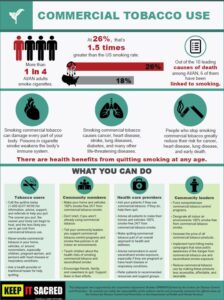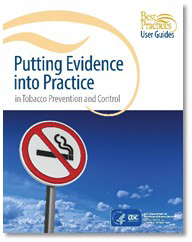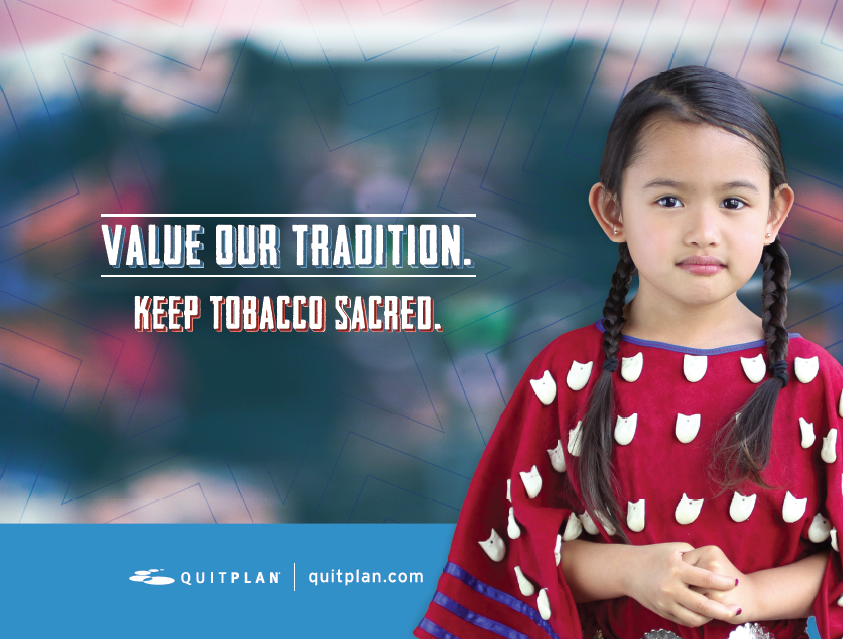Commercial Tobacco
Commercial Tobacco Use Infographic: More than 1 in 4 AI/AN adults smoke cigarettes. At 26%, that's 1.5 times greater than the US smoking rate. Out of the 10 leading causes of death among AI/AN, 6 of them have been linked to smoking. To download the full .pdf infographic, scroll down.

Commercial tobacco is manufactured by companies for recreational and habitual use in cigarettes, smokeless tobacco, pipe tobacco, cigars, hookahs, and other products. Commercial tobacco is mass-produced and sold for profit. It contains thousands of chemicals and produces over 7,000 chemical compounds when burned, many of which are carcinogenic, cause heart and other diseases, and premature death.1 Nicotine is the primary addictive substance contained in commercial tobacco. Nicotine causes an almost immediate stimulation in the user, followed by depression, which causes the user to crave more.2 Alongside the process of addiction, nicotine harms health by accelerating heart rate, reducing oxygen supply to body tissues, constricting blood vessels and raising blood pressure, which weakens organs, such as the heart, over time.3
"Losing your breath is losing your life force."
There is no safe level of exposure to commercial tobacco smoke and the damage from commercial tobacco smoke is immediate. The 2014 Surgeon General’s Report on Smoking and Health documented causal associations between smoking and 15 different cancers (i.e. lung, colorectal, cervical, kidney, liver, stomach), heart disease, stroke, COPD, asthma, diabetes, and adverse health outcomes in cancer patients and survivors, among others. Secondhand smoke exposure has been causally associated with lung cancer, heart disease, sudden infant death syndrome (SIDS), reproductive effects in women (premature birth, low birth weight), and an increased risk for stroke as well.
Commercial tobacco is regulated by the Food and Drug Administration (FDA), under the Family Smoking Prevention and Tobacco Control Act,4 though the Act does not apply to cigars, little cigars, hookah, or pipe tobacco, or electronic nicotine devices. The FDA is currently in the process of establishing regulations over these commercial tobacco products, including advertising and promotion.5
Manufacturers have designed commercial tobacco products to be more attractive and addictive. Commercial tobacco companies have targeted American Indians and Alaska Natives in marketing, sponsoring events and giveaways, devising promotional strategies, and misappropriating cultural imagery and concepts.6,7
A disproportionate percentage of American Indian and Alaska Natives (AI/AN) use commercial tobacco compared to other ethnic groups in the United States. In 2014, the CDC reported that 26.1% of all AI/AN adults were cigarette smokers. This rate is compared to 19.4% for whites, 18.3% for African Americans, 12.1% for Hispanics and 9.6% for Asians. AI/AN adults also have the highest usage rate for smokeless tobacco and cigars, and for the use of multiple tobacco products.
Based on region, commercial tobacco abuse prevalence among AI/AN varies, with the Southwest being lower and the Northern Plains being much higher. Smoking prevalence rates have been documented within certain Tribes as being greater than 70% using the American Indian Adult Tobacco Survey, which was developed by the CDC and Tribes to improve the quality of data collection among AI/AN populations who are underrepresented in national surveys. Tribe-specific data also documents smoking initiation beginning before age eight and regular smoking beginning during the tween and teen years.
In some communities, commercial tobacco may be erroneously used in place of traditional tobacco for ceremonies. However, traditional and commercial tobacco differ in the way that they are planted and grown, harvested, prepared, and used. Commercial tobacco use prevention and cessation outreach among American Indians and Alaska Natives should be informed by and tailored to the Tribal community’s culture.
TOBACCO ABUSE IMPACT
High commercial tobacco use rates among American Indians and Alaska Natives are directly reflected in the disproportionate rates of chronic diseases in AI/AN populations, where six of the top eight causes of death are linked to smoking. The leading cause of cancer death among American Indian and American Native populations is lung cancer.
AI/AN also suffer from much higher rates of asthma than any other ethnic group. The incidence of asthma among AI/AN children is 20% higher than any other ethnic group and AI/AN adults are 60% more likely to be diagnosed with the condition compared to adults in other ethnic groups.
There is no safe level of exposure to commercial tobacco smoke, and the damage from commercial tobacco smoke is immediate. Commercial tobacco abuse prevention and cessation are vital for American Indian and Alaska Native health and well-being.
Commercial Tobacco Resources
Webinar: Thirdhand Smoke: What Every Legal Professional Needs to KNow
In addition, here are some key resources referenced during the webinar:
- "There is no Constitutional Right to Smoke or Toke"
- Best Practices for Smoke Free MUH
- Smokefree Multiunit Housing Model Ordinance
- Resource Kit: Multiunit Housing and Thirdhand Smoke
- Email to receive a 'Do-it-Yourself Testing and Referral kit
Additional answers and common questions regarding thirdhand smoke prevention and remediation can be found at Thirdhand Smoke Resource Center.
Best Practices User Guide: Putting Evidence into Practice in Tobacco Prevention and Control
The Centers for Disease Control and Prevention’s (CDC’s) Office on Smoking and Health has published a new Best Practices User Guide: Putting Evidence into Practice in Tobacco Prevention and Control. The guide was written in partnership with the Center for Public Health Systems Science at Washington University in St. Louis.
After more than 50 years of research, we know what works to reduce commercial tobacco use. Yet evidence-based interventions are not reaching the people who need them most, and tobacco use still remains the leading cause of preventable death in the U.S. Dissemination and implementation (D&I) strategies can help close the gap between research and practice by turning what we know into what we do. This User Guide is designed to help programs share information about what works to reduce commercial tobacco use and put new or improved tobacco control interventions into practice.
The Best Practices User Guide: Putting Evidence into Practice in Tobacco Prevention and Control can help you:
- Identify, disseminate, and implement evidence-based tobacco control interventions;
- Learn from real‐world examples of how state programs have used D&I strategies to advance tobacco control goals;
- Make the case for investing in D&I efforts; and
- Identify the best resources and tools to get started.
Overview of warning letters for online retailers
This webinar provides online tobacco retailers with information including:
- An overview of FDA's internet and publication surveillance
- Why online retailers might receive warning letters
- How online retailers should respond to FDA's warning letters
Office of Small Business Assistance
This webinar provides tobacco retailers, manufacturers, and stakeholders with information about CTP's Office of Small Business Assistance (OSBA), including OSBA's free online resources and how to submit tobacco related questions to OSBA.
Being a current or former cigarette smoker increases the risk of severe illness from COVID-19
CDC: Adults of any age with the health conditions listed can be more likely to get severely ill from COVID-19.
Smokefree Stories with Virginia Chosa
From Americans for Non-Smokers Rights Foundation
Smokefree Stories with Virginia Chosa highlights a Tribal elder's perspective living in a multi-unit housing complex in Lac du Flambeau, Wisconsin. The video takes place on the Lac du Flambeau Indian Reservation and refers to Tribal housing and Tribal Housing Authority. Many sovereign Tribes receive funding from the US Department of Housing and Urban Development to provide housing to Tribal citizens living on reservations. It is structured similar to Public Housing Authorities except Tribes are granted autonomy via the Native American Housing Assistance and Self Determination Act of 1996.
From Smokefree.gov
https://smokefree.gov/quit-smoking/smoking-and-covid19
COVID-19 has many people feeling stressed, alone, or worried about their health. It’s a lot to deal with if you’re trying to stop smoking or stay smokefree if you used to smoke. But not smoking (or using any tobacco products) is one of the best ways to protect and improve your health.
Look below for resources and additional information from Smokefree.gov:
https://smokefree.gov/quit-smoking/smoking-and-covid19
Minnesota’s American Indian Nations have tobacco traditions that were passed down for generations. But those traditions have also been corrupted by the commercial tobacco industry, which today profits off the recreational abuse of plants that were sacred medicines for indigenous people.
Commercialization and direct marketing using American Indian images have led to an epidemic-level health problem in Minnesota’s tribal communities. Today, the cigarette smoking rate for American Indians is 59 percent – four times that of the general population (14 percent).
At the same time, American Indian people in Minnesota are working to restore traditional tobacco practices, to reduce commercial tobacco abuse like cigarette smoking, and to prevent secondhand smoke exposure. To help, ClearWay Minnesota collaborated with Minnesota tribes to create Keep Tobacco Sacred, an advertising campaign that reminds and educates about the differences between traditional and commercial tobacco. Components have included billboards, radio ads, and art projects like murals and exhibitions of Native artwork.
In 2016, ClearWay Minnesota also collaborated with Twin Cities PBS (TPT) on Reclaiming Sacred Tobacco, a 30-minute documentary on the tobacco practices of Anishinaabe and Dakota people in Minnesota. Beginning on November 13 at 7 p.m., to coincide with Native American Indian Heritage Month, Reclaiming Sacred Tobacco will air on TPT’s MN Channel. The video can also be streamed here:
PDF ARTICLE: MEASURING INDOOR AIR QUALITY AND ENGAGING CALIFORNIA INDIAN STAKEHOLDERS AT THE WIN-RIVER RESORT AND CASINO: COLLABORATIVE SMOKE-FREE POLICY DEVELOPMENT
Abstract: Most casinos owned by sovereign American Indian nations allow smoking, even in U.S. states such as California where state laws restrict workplace smoking. Collaborations between casinos and public health workers are needed to promote smoke-free policies that protect workers and patrons from secondhand tobacco smoke (SHS) exposure and risks. Over seven years, a coalition of public health professionals provided technical assistance to the Redding Rancheria tribe in Redding, California in establishing a smoke-free policy at the Win-River Resort and Casino. The coalition
provided information to the casino general manager that included site-specific measurement of employee and visitor PM2.5 personal exposure, area concentrations of airborne nicotine and PM2.5, visitor urinary cotinine, and patron and staff opinions (surveys, focus groups, and a Town Hall meeting). The manager communicated results to tribal membership, including evidence of high SHS exposures and support for a smoke-free policy. Subsequently, in concert with hotel expansion, the Redding Rancheria Tribal Council voted to accept a 100% restriction of smoking inside the casino, whereupon PM2.5 exposure in main smoking areas dropped by 98%. A 70% partial-smoke-free policy was instituted ~1 year later in the face of revenue loss. The success of the collaboration in promoting a smoke-free policy, and the key element of air quality feedback, which appeared to be a central driver, may provide a model for similar efforts.
PDF AMERICAN INDIANS/ALASKA NATIVE Commercial Tobacco Use
National Native Network American Indian/Alaska Native Commercial Tobacco developed an Infographic in 2015 with up to date statistics on smoking rates and resources for tribal health systems and communities.
Link CDC TIPS CAMPAIGN - AMERICAN INDIANS/ALASKA NATIVES
Centers for Disease Prevention and Control's Tips from Former Smokers: real stories from Nathan, a member of the Oglala Sioux Tribe, and Michael, a member of the Tlingit Tribe.
Link DISPARITIES IN SMOKING-RELATED MORTALITY AMONG AMERICAN INDIANS/ALASKA NATIVES
Mowery PD, et. al., article published in the American Journal of Preventive Medicine 2015. Smoking-related disparities continue to be a public health problem among American Indian/Alaska Native (AI/AN) population groups and data documenting the health burden of smoking in this population are sparse. The purpose of this study was to assess mortality attributable to cigarette smoking among AI/AN adults relative to non-Hispanic white adults (whites). Findings underscore the need for comprehensive tobacco control and prevention efforts that can effectively reach and impact the AI/AN population.
Link VITAL SIGNS: DISPARITIES IN NONSMOKERS' EXPOSURE TO SECONDHAND SMOKE
U.S. Department of Health and Human Services 2015 publication on nonsmokers' exposure to secondhand smoke in the U.S. 1999-2012.
Link Manipulating a Sacred Tradition
American Cancer Society. Manipulating a Sacred Tradition: An Investigation of Commercial Tobacco Marketing & Sales Strategies on the Navajo Nation and other Native Tribes Report.
Link Tobacco Industry Marketing
Centers for Disease Prevention and Control. 2014. Tobacco Industry Marketing
LINK THE HEALTH CONSEQUENCES OF SMOKING - 50 YEARS OF PROGRESS: A REPORT OF THE SURGEON GENERAL, 2014
Comprehensive report on commercial tobacco use in the United States with national data on incidence, up-to-date on health consequences of smoking, best and promising practices, and future directions in commercial tobacco control.
LINK NATIONAL INSTITUTES OF HEALTH: TOBACCO/NICOTINE
Website with up-to-date data and resources on commercial tobacco abuse in the United States.



